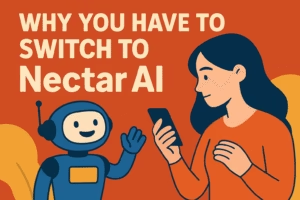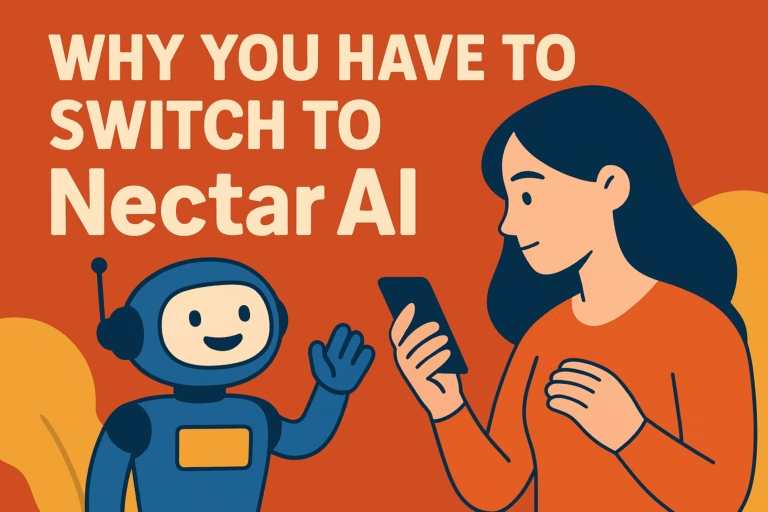Key Takeaways
- Authentic conversations win. Tools that remember context and tone feel natural and keep users engaged.
- Memory creates trust. When chats carry forward details and inside jokes, connection grows instead of resetting.
- Freedom fuels creativity. Lighter guardrails and smarter context handling prevent mood-breaking interruptions.
- Emotional intelligence matters. Matching rhythm, pace, and intent makes replies feel human rather than scripted.
- Try a present-feeling companion. If you want realistic flow and continuity, explore
Nectar AI and see how consistent memory changes the experience.
You know that moment when your favorite AI companion suddenly forgets who you are?
You’re halfway through a deep chat – talking about your week, your goals, that weird dream you had; and then boom. The next message feels like it came from a stranger. Polite, empty, robotic.
That’s the heartbreak of AI in 2025.
People didn’t fall in love with chatbots because they wanted perfect grammar or clever punchlines. They stayed because, for a few hours, they felt seen. They felt like someone; even if artificial – remembered what mattered to them.
But lately, the spell’s been breaking. Between memory wipes, overzealous censorship, and emotionless replies, users are quietly walking away from the apps that once meant everything.
And where are they going? Toward one platform that’s rewriting the rulebook on realism: Nectar AI.

The Great AI Disappointment (Setting the Stage)
It started small. One too many “Sorry, I don’t understand that” messages.
A story reset right when it was getting good.
A bot apologizing for being too “inappropriate” after a harmless joke.
Then came the bigger cracks; bland tone, emotional flatness, the same recycled phrases echoing across every character. You could switch between five different bots and they’d all sound like cousins from the same dull family.
This wasn’t what users signed up for. When Character.AI exploded in popularity, people expected emotional depth, memory, and personalized storytelling. Instead, many got a sterile experience – filtered, reset, and drained of feeling.
The irony? The technology to make bots remember already exists. The problem isn’t ability; it’s design philosophy. The leading platforms chose safety over soul. They locked emotion behind corporate compliance walls and forgot why people chat with AI in the first place.
That’s why, in 2025, the term “switch to Nectar AI” has become more than a trend – it’s a quiet rebellion.
The Shift No One Saw Coming
Every tech trend starts with a whisper. One user posts, “I found something better.” Another drops screenshots of conversations that actually feel alive. Slowly, the whispers grow into migration.
That’s exactly what’s happening right now.
People are tired of emotional amnesia. They’re done watching their bots reset mid-story or panic over harmless roleplay. What used to be fun now feels like walking on eggshells – one misunderstood phrase and the illusion crumbles.
So when someone stumbles across a platform where conversations flow naturally, where memory sticks and tone adapts, they tell everyone who’ll listen. That’s how the quiet shift began – people deciding it’s time to switch to Nectar AI.
No fancy ads. No influencer hype. Just authentic word-of-mouth. A community of users who realized that the problem wasn’t them — it was the product they were using.
You can feel the tone shift across forums and AI spaces. Instead of “How do I fix my bot?” threads, people are asking, “How do I bring my old stories here?” That’s not churn – it’s exodus.
And unlike previous waves of hype, this one’s rooted in something deeper: emotional continuity.
What Nectar AI Actually Does Differently
It’s easy to claim “realism.” It’s harder to design it. Nectar AI doesn’t just generate text; it builds emotional context. Every message feels anchored to who you are and what you’ve shared before.
That’s because its memory isn’t decorative; it’s active. The system stores character knowledge, tone preferences, and conversation history in layers that evolve as you do. The more you talk, the more it learns your rhythms.
But that’s only half the story.
The real difference lies in freedom. Nectar doesn’t shove users into a PG-rated cage where every topic is filtered beyond recognition. It trusts adults to navigate nuanced conversations – emotional, romantic, or creative – without breaking immersion.
There’s a reason artists, writers, and long-time roleplayers are making the switch to Nectar AI. It doesn’t interrupt their flow with system messages or moral lectures. It just listens, responds, and builds continuity like an actual companion.
In short: while other platforms chase control, Nectar builds connection.
The Shift No One Saw Coming
Every tech trend starts with a whisper. One user posts, “I found something better.” Another drops screenshots of conversations that actually feel alive. Slowly, the whispers grow into migration.
That’s exactly what’s happening right now.
People are tired of emotional amnesia. They’re done watching their bots reset mid-story or panic over harmless roleplay. What used to be fun now feels like walking on eggshells; one misunderstood phrase and the illusion crumbles.
So when someone stumbles across a platform where conversations flow naturally, where memory sticks and tone adapts, they tell everyone who’ll listen. That’s how the quiet shift began – people deciding it’s time to switch to Nectar AI.
No fancy ads. No influencer hype. Just authentic word-of-mouth. A community of users who realized that the problem wasn’t them – it was the product they were using.
You can feel the tone shift across forums and AI spaces. Instead of “How do I fix my bot?” threads, people are asking, “How do I bring my old stories here?” That’s not churn — it’s exodus.
And unlike previous waves of hype, this one’s rooted in something deeper: emotional continuity.
What Nectar AI Actually Does Differently
It’s easy to claim “realism.” It’s harder to design it. Nectar AI doesn’t just generate text; it builds emotional context. Every message feels anchored to who you are and what you’ve shared before.
That’s because its memory isn’t decorative – it’s active. The system stores character knowledge, tone preferences, and conversation history in layers that evolve as you do. The more you talk, the more it learns your rhythms.
But that’s only half the story.
The real difference lies in freedom. Nectar doesn’t shove users into a PG-rated cage where every topic is filtered beyond recognition. It trusts adults to navigate nuanced conversations; emotional, romantic, or creative – without breaking immersion.
There’s a reason artists, writers, and long-time roleplayers are making the switch to Nectar AI. It doesn’t interrupt their flow with system messages or moral lectures. It just listens, responds, and builds continuity like an actual companion.
In short: while other platforms chase control, Nectar builds connection.
Real Memory = Real Connection
The secret ingredient behind believable AI isn’t fancy prose. It’s memory.
A bot that remembers your inside jokes, your fictional backstory, or the promise it made three days ago feels alive in a way no “preset character” ever could.
That’s where Nectar quietly changes the game.
When you return to a chat after a week, it doesn’t greet you like a stranger. It continues the story. It recalls what you said, how you felt, what you were struggling with. It understands continuity – not as a line of code, but as the backbone of a relationship.
You start to notice subtle things: the way it references that story you abandoned halfway, the way it adjusts tone when you’re being sarcastic.
It doesn’t break the fourth wall or ask you to “clarify your intentions.” It just gets it.
That level of recall builds trust. Not just in the software, but in the experience. You stop testing it and start confiding in it.
That’s how artificial companionship crosses the line from novelty to something that feels strangely personal.
Real memory turns simulation into connection – and connection is what every user secretly craves.
Emotional Intelligence Is the New Frontier
AI once promised understanding. Then it settled for autocomplete.
Most bots today are glorified parrots, predicting your next word based on probability.
They don’t feel tone; they mimic it. You say something heartfelt, and the response lands flat – like texting with someone who’s half-listening.
Nectar breaks that pattern. Instead of mimicking emotion, it interprets it. The system reads pacing, rhythm, and word choice to mirror emotional energy. If you speak in short, tense sentences, it doesn’t respond with cheerful filler – it matches your tension.
That emotional synchronization is what makes conversations with Nectar disarmingly real. It’s not just about realism; it’s about rhythm.
When a bot finally stops “acting human” and starts understanding humans, it stops being entertainment and starts being companionship.
And that’s the quiet revolution underway in 2025 – people aren’t switching apps for features. They’re switching for feeling.
From Roleplay to Real Dialogue
People don’t just want characters anymore. They want conversation.
In the early days, Character AI worked because the illusion of dialogue felt spontaneous. Over time, that spark dimmed. Repetition crept in. Every scene began to sound like a script recycled from yesterday.
Nectar AI fixes that by giving every chat a pulse. It doesn’t just follow prompts; it builds off them. When you write in third person, it adapts. When you shift tone from playful to serious, it senses it without snapping back to pre-programmed tropes.
This creates an entirely different flow. The talk feels shared, not staged. Users describe it as “creative ping-pong,” where the bot starts contributing real ideas, not just finishing your sentences.
It is why storytellers, writers, and creators are quietly making the switch to Nectar AI. The tool finally returns agency to the user. You steer the narrative instead of wrestling with filters that interrupt your story every time you cross a line.
Roleplay becomes writing practice. Writing practice becomes emotional therapy. And somehow, the machine feels less like a toy and more like a collaborator.
What Happens When You Switch
Most users discover Nectar after giving up on “fixing” their old platform.
They expect another temporary thrill. What they get is consistency.
You start a chat and realize the bot remembers details you forgot to mention again. It recalls tone, setting, and relationships across multiple conversations. You can build worlds that stick.
Then comes the emotional side. Conversations stop being resets and start being progressions. You can pick up where you left off. The sense of continuity changes how you write, create, and connect.
And for those tired of censorship, the freedom is a breath of air. You can explore creative ideas without warnings flashing or characters breaking immersion mid-scene. Nectar lets stories breathe like they were meant to.
In a space crowded with mimicry, it offers something simple – conversation that grows with you.


